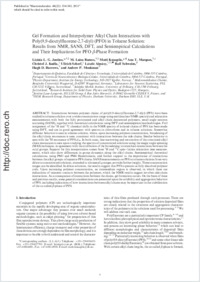Gel formation and interpolymer alkyl chain interactions with poly (9,9-dioctylfluorene-2,7-diyl) (PFO) in toluene solution: NMR, SANS, DFT, and results from semiempirical calculations and their implications for PFO β-phase formation
- Justin, Licínia L. G. Departamento de Qumica, Faculdade de Cincias e Tecnologia, Universidade de Coimbra, Portugal
- Ramos, M. Luísa Departamento de Qumica, Faculdade de Cincias e Tecnologia, Universidade de Coimbra, Portugal
- Knaapila, Matti Physics Department, Institute for Energy Technology, NO-2027 Kjeller, Norway
- Marques, Ana T. Makromolekulare Chemie, Bergische Universitt Wuppertal, D-42097 Wuppertal, Germany
- Kudla, Christof J. Makromolekulare Chemie, Bergische Universitt Wuppertal, D-42097 Wuppertal, Germany
- Scherf, Ullrich Makromolekulare Chemie, Bergische Universitt Wuppertal, D-42097 Wuppertal, Germany
- Almásy, László Laboratory for Neutron Scattering, Villigen, Switzerland - Adolphe Merkle Institut, University of Fribourg, Switzerland
- Schweins, Ralf Institut Laue-Langevin, DS/LSS Group, Grenoble, France
- Burrows, Hugh D. Departamento de Qumica, Faculdade de Cincias e Tecnologia, Universidade de Coimbra, Portugal
- Monkman, Andrew P. OEM Research Group, Department of Physics, Durham University, U.K
-
27.12.2010
Published in:
- Macromolecules. - 2011, vol. 44, no. 22, p. 334-343
English
Interactions between polymer chains of poly(9,9-dioctylfluorene-2,7-diyl) (PF8) have been studied in toluene solution over a wide concentration range using multinuclear NMR spectral and relaxation measurements with both the fully protonated and alkyl chain deuterated polymers, small angle neutron scattering (SANS), together with theoretical calculations using DFT and semiempirical methodologies. Full assignment of the ¹H and ¹³C chemical shifts in the NMR spectra of isolated chains of PF8 has been made using DFT, and are in good agreement with spectra in chloroform and in toluene solutions. Somewhat different behavior is seen in toluene solution, where, upon increasing polymer concentration, broadening of the alkyl chain resonances is seen, consistent with interactions between the side chains. Similar behavior is seen with the ²H resonance of PF8-d₃₄. In both cases, line-narrowing and restoration of the structured alkyl chain resonances is seen upon studying the spectra of concentrated solutions using the magic angle spinning (MAS) technique, in agreement with the attribution of the broadening to interchain interactions between the octyl groups. Support for this interpretation comes from ¹H and ¹³C spin−lattice relaxation time measurements, which also show differences in group dynamics along the alkyl chains. Semiempirical theoretical calculations, using PM3 and PM6 Hamiltonians, add further support to the importance of interactions between the alkyl groups of separate PF8 chains. SANS measurements on PF8 in toluene solutions from very dilute to concentrated solutions, extended to ultrasmall q ranges, provide further insight. Three concentration ranges can be identified. In dilute solutions, the results suggest that PF8 is present as fully dissolved polymer coils. Upon increasing polymer concentration, an intermediate region is observed, in which there are indications of transient contacts between the polymers, which the NMR results suggest involves side chain interactions. As a consequence of interactions between the chains, gel formation occurs. On the basis of these and previous results, some general considerations are presented upon the solubility and aggregation behavior of PF8, including indications of how interactions between alkyl chains may be important in the stabilization of the so-called β-phase of PF8.
- Faculty
- Faculté des sciences et de médecine
- Department
- AMI - Soft Nanoscience
- Language
-
- English
- Classification
- Physics
- License
-
License undefined
- Identifiers
-
- RERO DOC 22441
- DOI 10.1021/ma102235r
- Persistent URL
- https://folia.unifr.ch/unifr/documents/301835
Other files
Statistics
Document views: 160
File downloads:
- pdf: 384
- Supplementary material: 125

